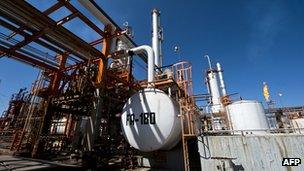Mexico's migrants return as the American dream fades
- Published

Rural towns are changing as migrants bring new influences
Silvano Ramos, 36, left his home of Chilcuautla, a town of 12,000 inhabitants in the central Mexican state of Hidalgo, 12 years ago. He left, like so many others, in search of the American dream.
He crossed the river Rio Grande - or Rio Bravo as it's known in Mexico - along the Texas border to work illegally as a construction worker in Nevada.
But when the US economy began to stall with the housing market collapse six years ago, he decided to leave that dream behind. Last January he became the mayor of Chilcuautla, where 80% of the population has a family member in the US.
He represents a new wave of Mexicans who are deciding to return home - though it is unclear whether their homeland is ready to take them all back.
Improving economy
"The sad situation is that we are not prepared to welcome so many migrants. It is worrying, there will be chaos if they start returning en masse, there's not much we can offer them here," Mayor Ramos tells the BBC.
Some 400,000 Mexicans returned last year, the country's National Migration Institute (INM) says.
The country's booming economy and improved living conditions are being cited by the government as reasons why fewer Mexicans leave for the United States.
However, in small towns like Chilcuautla, returning migrants add pressure to the local administration's budgets.
More money is needed for health care for the increased population, more places in public schools, more programmes to assist returning families. But there just aren't enough resources, Mr Ramos says.
For decades, Hidalgo has been one of the main departing points for migrants. But now it is seeing many people coming back from the US.
State authorities say that in 2011 20,000 people left Hidalgo to find a new life in the US. But during the same period, 10,000 'Hidalguenses' returned, a record figure for this part of the country.
"The difficulties in finding a job in the US and the threat of new immigration laws in states like Arizona have led to a curb in migration," says Carmen Dorantes, director of Hidalgo's government office to help returning migrants.
"Mexicans who live there are now deciding to return, or at least send some members of their families back to Mexico," she says.
Record deportations
Across the country, the situation is similar.
The number of Mexicans leaving their country for the US declined from more than one million in 2006 to 404,000 in 2010, a reduction of 60%, research by the Pew Hispanic Center suggests.

Oil still makes up a large part of Mexico's economy - but falling remittances are a worry
Many Mexicans have decided either to stay or return voluntarily, but others have been forced to come back home.
Deportations have reached record levels under President Barack Obama's administration.
The average number of deportations of illegal immigrants has been 400,000 per year since 2009, 30% higher than during President George W Bush's second term.
The return of the 'paisanos' (friends or compatriots), may also change the country's economy.
Mexico is heavily dependent on remittances from its nationals abroad; they represent the country's third-largest source of income after oil and tourism.
Remittances sent to Mexican nationals last year totalled $22.7bn, according to the National Bank of Mexico. This is less than was being sent before 2008's downturn, when more than $26bn dollars were sent every year.
Mexicans are bringing back American know-how, culture and money, which the authorities hope they will invest in Mexico.
"People come with their assets to establish new businesses. Those returning may speak three languages - English, Spanish and their local indigenous language. They have new skills. In a way, it will be easier for them to find a job than for those who never left the country," Mrs Dorantes says.
And that might cause some misgivings in the local communities, as the returning migrants change the make-up of their home towns, local authorities fear.
'New kind of Mexican'
"The first things you see now when getting to Hidalgo are new houses, bigger constructions, more like American architecture, and equipped with modern technology. These are the homes of the migrants," she says.
New kinds of businesses also flourish in the traditional towns, such as Chinese restaurants, pizza joints and English academies. These towns, even though the majority of their population are from indigenous cultures, are now experiencing American influences.
"There is a new culture coming from the north that is changing our communities, where the indigenous culture is still very powerful. For the first time you see young people with tattoos or piercings in our streets. They don't want to work as farmers, like their parents used to," Mrs Dorantes says.
"They are a new kind of Mexican."